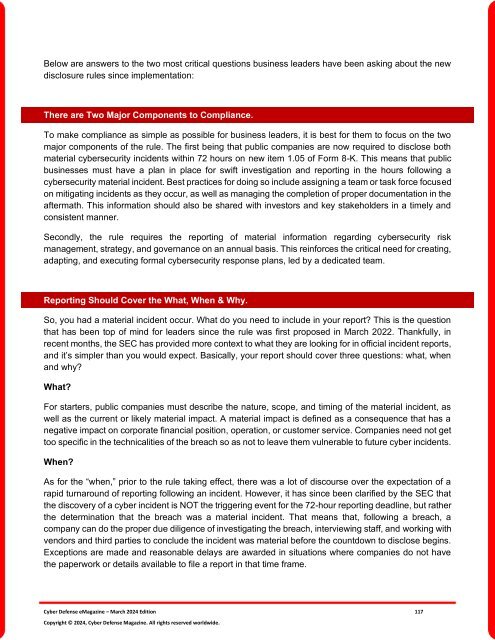The Cyber Defense eMagazine March Edition for 2024
Cyber Defense eMagazine March Edition for 2024 #CDM #CYBERDEFENSEMAG @CyberDefenseMag by @Miliefsky a world-renowned cyber security expert and the Publisher of Cyber Defense Magazine as part of the Cyber Defense Media Group as well as Yan Ross, Editor-in-Chief and many more writers, partners and supporters who make this an awesome publication! 225 page March Edition fully packed with some of our best content. Thank you all and to our readers! OSINT ROCKS! #CDM #CDMG #OSINT #CYBERSECURITY #INFOSEC #BEST #PRACTICES #TIPS #TECHNIQUES
Cyber Defense eMagazine March Edition for 2024 #CDM #CYBERDEFENSEMAG @CyberDefenseMag by @Miliefsky a world-renowned cyber security expert and the Publisher of Cyber Defense Magazine as part of the Cyber Defense Media Group as well as Yan Ross, Editor-in-Chief and many more writers, partners and supporters who make this an awesome publication! 225 page March Edition fully packed with some of our best content. Thank you all and to our readers! OSINT ROCKS! #CDM #CDMG #OSINT #CYBERSECURITY #INFOSEC #BEST #PRACTICES #TIPS #TECHNIQUES
You also want an ePaper? Increase the reach of your titles
YUMPU automatically turns print PDFs into web optimized ePapers that Google loves.
Below are answers to the two most critical questions business leaders have been asking about the new<br />
disclosure rules since implementation:<br />
<strong>The</strong>re are Two Major Components to Compliance.<br />
To make compliance as simple as possible <strong>for</strong> business leaders, it is best <strong>for</strong> them to focus on the two<br />
major components of the rule. <strong>The</strong> first being that public companies are now required to disclose both<br />
material cybersecurity incidents within 72 hours on new item 1.05 of Form 8-K. This means that public<br />
businesses must have a plan in place <strong>for</strong> swift investigation and reporting in the hours following a<br />
cybersecurity material incident. Best practices <strong>for</strong> doing so include assigning a team or task <strong>for</strong>ce focused<br />
on mitigating incidents as they occur, as well as managing the completion of proper documentation in the<br />
aftermath. This in<strong>for</strong>mation should also be shared with investors and key stakeholders in a timely and<br />
consistent manner.<br />
Secondly, the rule requires the reporting of material in<strong>for</strong>mation regarding cybersecurity risk<br />
management, strategy, and governance on an annual basis. This rein<strong>for</strong>ces the critical need <strong>for</strong> creating,<br />
adapting, and executing <strong>for</strong>mal cybersecurity response plans, led by a dedicated team.<br />
Reporting Should Cover the What, When & Why.<br />
So, you had a material incident occur. What do you need to include in your report? This is the question<br />
that has been top of mind <strong>for</strong> leaders since the rule was first proposed in <strong>March</strong> 2022. Thankfully, in<br />
recent months, the SEC has provided more context to what they are looking <strong>for</strong> in official incident reports,<br />
and it’s simpler than you would expect. Basically, your report should cover three questions: what, when<br />
and why?<br />
What?<br />
For starters, public companies must describe the nature, scope, and timing of the material incident, as<br />
well as the current or likely material impact. A material impact is defined as a consequence that has a<br />
negative impact on corporate financial position, operation, or customer service. Companies need not get<br />
too specific in the technicalities of the breach so as not to leave them vulnerable to future cyber incidents.<br />
When?<br />
As <strong>for</strong> the “when,” prior to the rule taking effect, there was a lot of discourse over the expectation of a<br />
rapid turnaround of reporting following an incident. However, it has since been clarified by the SEC that<br />
the discovery of a cyber incident is NOT the triggering event <strong>for</strong> the 72-hour reporting deadline, but rather<br />
the determination that the breach was a material incident. That means that, following a breach, a<br />
company can do the proper due diligence of investigating the breach, interviewing staff, and working with<br />
vendors and third parties to conclude the incident was material be<strong>for</strong>e the countdown to disclose begins.<br />
Exceptions are made and reasonable delays are awarded in situations where companies do not have<br />
the paperwork or details available to file a report in that time frame.<br />
<strong>Cyber</strong> <strong>Defense</strong> <strong>eMagazine</strong> – <strong>March</strong> <strong>2024</strong> <strong>Edition</strong> 117<br />
Copyright © <strong>2024</strong>, <strong>Cyber</strong> <strong>Defense</strong> Magazine. All rights reserved worldwide.

















